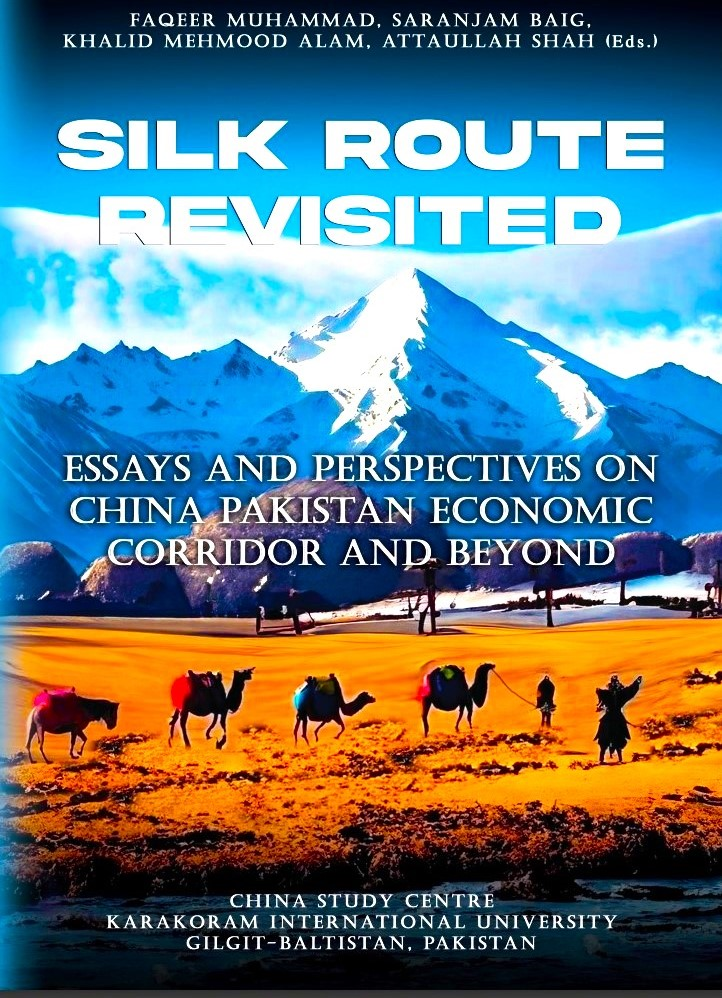Book Review: “Silk Route Revisited: Essays and Perspectives on the China-Pakistan Economic Corridor and Beyond”
GILGIT, Aug. 13 (Gwadar Pro) - The China-Pakistan Economic Corridor (CPEC) has achieved a decade of successful implementation, now embarking on its second phase. This milestone not only brings renewed optimism to the people of Pakistan but also stands as a concrete expression of Beijing’s unwavering belief in Pakistan’s forthcoming advancements and prosperity.

In a dedicated effort to delve into Pakistan’s historical connections with the ancient Silk Road as well as its engagement with the modern iteration, the China Study Centre (CSC) at Karakoram International University, Gilgit Baltistan, has unveiled an illuminating publication. This comprehensive book titled “Silk Route Revisited: Essays and Perspectives on the China-Pakistan Economic Corridor and Beyond” intricately weaves together insights. The focus not only encompasses the profound impact of the CPEC but also extends beyond its transformative potential for Pakistan.
Edited collaboratively by Faqeer Muhammad, Saranjam Baig, Khalid Mehmood Alam, and Attaullah Shah, the comprehensive fifteen-chapter volume stands as a testament to the intricate efforts of CSC, KIU, Gilgit Baltistan. The book’s cover and layout have been meticulously crafted by the skilled hands of Karim Muhammad, adding an aesthetic touch to the insightful contents within.
In its inaugural chapter, the book conducts an in-depth analysis of CPEC’s impact on trade, specifically examining transport costs and travel durations. A crucial comparison is drawn between the conventional routes and the novel CPEC path. The findings are striking, revealing a substantial reduction in transport expenses for a 40-foot container traveling between Kashgar and the Middle East, plummeting by approximately $1450. Similarly, costs to European destinations dipped by $1350. As a significant time-saving advantage, the corridor will cut travel durations by 21 to 24 days for Middle Eastern ports and 21 days for European counterparts.
In the second chapter, the book delves into the perspectives of Pakistani stakeholders regarding CPEC’s potential impact on diverse aspects of tourism. It scrutinizes their readiness to capitalize on CPEC’s tourism opportunities, examines their proposed strategies for orchestrating and discussing tourism investments with China.
Moving forward, the subsequent chapter underscores the significance of the blue economy within the CPEC framework. In Chapter 4, the focus turns toward the dynamic Pakistan-China relationship, shedding light on the enduring camaraderie that has consistently anchored Pakistan’s foreign policy approach.
The book’s fifth chapter delves into the correlation between the awareness of the CPEC among residents and their outlook on tourism growth within the Gilgit-Baltistan region.
In Chapter 6, the book explored how the entrepreneurial landscape in the country would be reshaped by the CPEC. The corridor’s overarching objective is to elevate living standards, foster poverty reduction, and bridge the developmental divide between urban and rural areas of Pakistan.
Chapter 7 of the book underscores Pakistan’s escalating urbanization and its pivotal role in ensuring energy security. In Chapter 8, an in-depth analysis of the two cultures is presented, both theoretically and empirically. Chapter 9 delves into the geopolitical and economic significance of Gilgit-Baltistan, situated strategically amidst ongoing regional developments. Turning to Chapter 10, a comprehensive exploration of the favorable economic implications of CPEC in Pakistan is outlined. In Chapter 11, the focus shifts to the impact of Chinese learning motivation on international students’ proficiency, with a survey conducted on Pakistani students studying Chinese in China. Chapter 12 highlights the crucial facets of educational, cultural, and bilateral collaboration between China and Pakistan, emphasizing their remarkable recent growth. Chapter 13 takes a global perspective on CPEC, examining how diverse countries across Asia, Europe, and Africa can benefit from this initiative. The authors advocate for CPEC to be a mutually beneficial arrangement for all participating nations.
In Chapter 14, the book delves into the pivotal role of food and agriculture within the CPEC framework, drawing insights from China's successful cultivation of ‘Morels’—wild edible treasures known for their nutritional, health, and economic value.
The final chapter addresses the potential challenges posed by climate uncertainties and natural hazards along the CPEC route. The Karakoram region in northern Pakistan boasts some of the world’s highest mountain peaks, with the Karakoram Highway traversing these rugged terrains to connect Pakistan and China.




